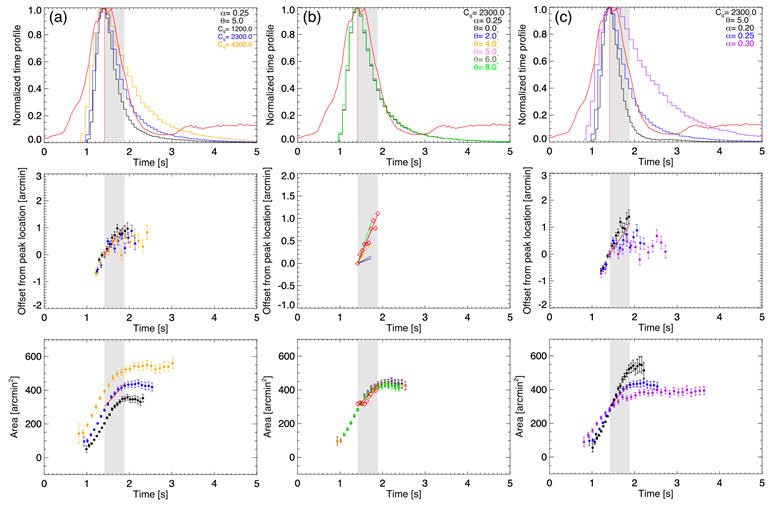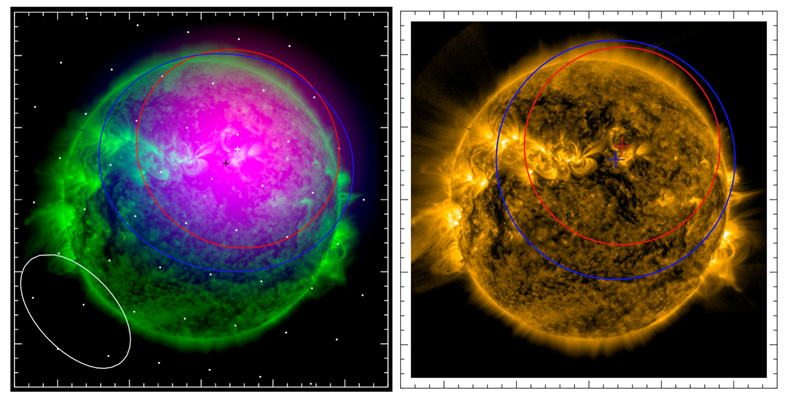Recent studies (Kontar et al. 2017) of a Type III–IIIb burst observed by LOFAR (van Haarlem et al. 2013) indicated that the temporal variations in the positions and source sizes do not fit into the standard picture of type III solar radio bursts and require a better understanding of radio-wave transport. With the aim of explaining the observed properties of type III–IIIb solar radio bursts, we use radio-wave simulations of radio-wave propagation to investigate the time evolution, positions, and sizes of the apparent solar radio burst sources for both the fundamental and harmonic components at subsecond scales. The radio waves can be strongly affected by the inhomogeneous density fluctuations while they propagate away from the Sun. Those propagation effects, including the refraction due to plasma density gradients and scattering by small-scale density fluctuations, can significantly affect the apparent properties of the radio sources, including their time evolution, position, and size (Steinberg et al. 1971; Arzner & Magun 1999; Thejappa et al. 2007; Krupar et al. 2020; Bian et al. 2019).
The radio waves were treated as a series of photons propagating through the turbulent corona. Their positions and wave vector were derived from the same theoretical expressions and numerical approach as in Kontar et al. (2019). A histogram of the ray arrival times can be regarded as the time profile of radio emissions. The temporal evolution, apparent sizes, and locations of radio sources simulated assuming an anisotropic turbulence with different spectrum-averaged mean wavenumbers (Cq), heliocentric angles (θ) and anisotropy parameters(α) are shown in Figure 1 for the fundamental emission. Here, Cq characterizes the density fluctuation properties that is a composite of the density fluctuation levels ε, the lo and li, the outer and inner scales of the inhomogeneities. Anisotropic scattering description with an α is required because the isotropic scattering cannot simultaneously describe all the observed radio emission characteristics, seen in the details from Chen et al. (2020).

Figure 1. Simulations of fundamental plasma emission from an instantaneous point source scattered by anisotropic turbulence, with the effects of, (a) different mean wavenumbers Cq of the density fluctuations, (b) varying the heliocentric angle θ, and (c) the anisotropy parameter α. The time profiles (top row), the shifts of the apparent source centroids (middle row), and the apparent source areas (bottom row) with respect to time were compared with LOFAR observations (red data) of the type III–IIIb radio burst at 32.5 MHz from Kontar et al. (2017).
We found that radio-wave scattering due to turbulence with Cq=2300 R☉-1, θ=5° and α~0.25 can simultaneously match the main characteristics of the fundamental sources observed by LOFAR, seen in the red lines from Figure 1. We also simulated the harmonic emission using the same parameters, and found that it can be explained by the same parameters of turbulence when the harmonic has a finite source area of 200 arcmin2 and finite emission time. Using the obtained parameters to simulate both the fundamental and harmonic sources, we successfully reproduce the observed sources, presented in Figure 2.

Figure 2. Observed (left panel, from Kontar et al. (2017)) and simulated (right panel, from Chen et al. (2020)) radio sources of the fundamental (red contour) and harmonic (blue contour) components, overlaid on an SDO/AIA 171 Å image. The fundamental sources were simulated using Cq=2300 R☉-1, θ=5° and α~0.25. The harmonic source was simulated using the injection profile of a finite emission area of 200 arcmin2 shown in Figure 5 from Chen et al. (2020). Both the simulated fundamental and harmonic sources were considered to add a beam size of 110 arcmin2.
By matching simultaneously the main characteristics (time profile, position and size) of the observed sources with those observed by LOFAR, we have estimated the properties of plasma turbulence in the solar corona. Given that the observed radio properties do not represent the intrinsic source properties, radio-wave propagation effects should be taken into account when inferring physical parameters using solar radio-imaging observations. The comparison of simulations to observations of source sizes and positions at subsecond timescales allows us to understand the propagation of radio waves, and provide a useful tool to diagnose the turbulence in the solar corona.
Based on the recently published paper: Xingyao Chen, Eduard P. Kontar, Nicolina Chrysaphi, Natasha L. S. Jeffrey, Mykola Gordovskyy, Yihua Yan, and Baolin Tan, Subsecond Time Evolution of Type III Solar Radio Burst Sources at Fundamental and Harmonic Frequencies, The Astrophysical Journal, 905:43 (2020) DOI: 10.3847/1538-4357/abc24e
References
Arzner, K., & Magun, A. 1999, A&A, 351, 1165
Bian, N. H., Emslie, A. G., & Kontar, E. P. 2019, ApJ, 873, 33
Kontar, E. P., Chen, X., Chrysaphi, N., et al. 2019, ApJ, 884, 122
Kontar, E. P., Yu, S., Kuznetsov, A. A., et al. 2017, NatCo, 8, 1515
Krupar, V., Szabo, A., Maksimovic, M., et al. 2020, ApJS, 246, 57
Steinberg, J. L., Aubier-Giraud, M., Leblanc, Y., & Boischot, A. 1971, A&A, 10, 362
Thejappa, G., MacDowall, R. J., & Kaiser, M. L. 2007, ApJ, 671, 894
van Haarlem, M. P., Wise, M. W., Gunst, A. W., et al. 2013, A&A, 556, A2
